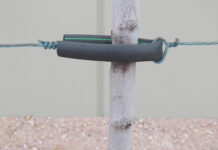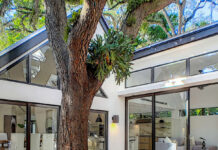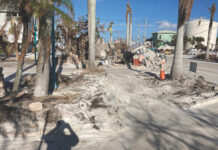By John C. Fech
From the October 2023 Issue
Healthy trees with good form and branch structure resist storms much better than those that have been neglected or developed defects and maladies over the years. The first step in lowering the risk associated with trees on client properties is to give them a thorough inspection, making notes on observations that “just don’t look right.” Green Industry professionals who can spot and address these issues are a step above the rest; making property owners aware of a hazardous tree is an added service.
Unfortunately, not all trees are the rosy asset they are perceived to be. They almost always have defects that can be dangerous. Decay, cracks, co-dominant leaders, leaning, basal root problems, overextended branches, deep planting, and stem girdling roots pose real threats to the stability of a tree on a property – especially in the context of being storm-ready. Trees in a target-rich environment, meaning those in proximity to human activity or items of value, are obviously of primary importance.

Storm Resilience: What To Look For
Here’s a quick primer on the defects to look for when assessing trees for storm resilience:
Decay. All tissues on a tree – bark, cambium, sapwood, heartwood, flowers, fruits – can decay or become softened and non-functional. The classic decay areas are: recent saw cuts from branch removals where the wound hasn’t closed completely, and the trunk base where injury may have occurred from turf maintenance equipment. But essentially, decay can develop most anywhere on a tree.
Cracks. A physical separation of bark, sapwood, and heartwood is very problematic because it creates a significant vertical weakness in the tree.
Co-dominant leaders. Early competition for a leader results in two or three stems of equal or near-equal size at the top. The strongest, most upright stem should remain, and the others removed to produce a terminal with one healthy, sturdy leader. Failure to remove all but one results in included bark, a point of significant weakness in the crown.
Leaning. A tree stretching or growing in the direction of sunlight is no trouble, but one that has tilted on its axis is problematic. Exposed roots, or even a bump of raised soil on one side, is a symptom that roots have torn loose from the soil particles and have lifted out of the ground.
Overextended branches. Branches that have grown well beyond the canopy with relatively large or extensive stems and foliage are ones that can exert tremendous pressure on the main trunk.
Lion’s tailing. The poor arboricultural practice of removing all inner stems from a scaffold branch creates a condition where the outer periphery will whip around excessively when windstorms exert significant energy.
Elevation. This is a similar poor practice where many of a tree’s lower limbs have been removed in an attempt to increase sunlight to the turf below. It greatly reduces the tree’s capacity to diffuse the energy of a storm.
Deep planting. A failure of the trunk to develop adequate taper, essentially rising out of the ground like a telephone pole, is a symptom of overly deep planting. When the upper horizontal roots are buried more than 6″ below grade, the tree’s capacity to remain upright in a storm is greatly reduced.
Stem girdling roots. Horizontal roots that encircle the root mass in the weeks following planting, instead of growing laterally, create pressure on the conductive vessels of the trunk as well as an inclusion where bark of the trunk pushes on the bark of the roots, decreasing stability at the base/bole of the tree. (For more on the problem of root girdling, see “The Root Of The Issue.”
Once major defects are identified and storm resilience recommendations made, it’s time to move on to traditional tree hazard awareness issues. Though each situation is different and fueled by the property owner’s budget, consideration of species, age, location, function, and condition will provide a thorough analysis for each tree specimen.
A typical example would be a silver maple tree in a couple’s back yard. It’s the only tree in the yard, has a tire swing attached, and casts wonderful shade on the patio table. Since a silver maple is relatively soft-wooded, heartwood decay advances much more quickly than in a pecan or red oak. For this reason, paying close attention to the size, depth, and internal height of the rot pocket is of primary concern. The surface roots, however, are typical of silver maple, and not of concern.
Seek Confirmation: TRAQ
Once you’ve noted and documented suspected areas of concern, confirm the issues with an ISA Certified Arborist, preferably one with a Tree Risk Assessment Qualification (TRAQ). If you don’t have a consultant on hand in your local area, don’t fret; they’re easy to find. A simple visit to the ISA web site at isa-arbor.com will get you started. The common sense approach is to discuss each tree, one by one, considering various aspects of each suspected malady. A Registered Consulting Arborist is another good option for confirmation.
Is TRAQ really necessary? Yes, and for various reasons. A TRAQ qualified arborist has the experience, training, and equipment to perform a studious and thorough assessment of trees identified as having possible defects. In most cases, the arborist will also be able to spot and assess trees that don’t initially appear to have anything wrong with them.
Finally, in terms of liability, a property owner has a certain degree of exposure an inherent responsibility to ensure the property is safe. In the TRAQ world, this is referred to as “Duty of Care,” or a tree owner’s responsibility to ensure a reasonable degree of safety for people or property near the trees.
The tree care provider’s responsibility, on the other hand, is termed “Standard of Care,” meaning the degree of care a reasonably prudent person should provide. Ignoring these responsibilities is a “breach” or failure to act responsibly, which can lead to “neglect,” or failure to use reason- able care resulting in damage or injury to another. The main purposes of pre-storm assessment are to act responsibly; prevent tree, human, and property damage; and avoid litigation in court.

Fix It Or Get Rid of It?
When a tree is problematic, it either needs to be remediated or removed. Ask the following questions:
- Can weak branch attachments, hangers, rubbing limbs, and tear-offs be corrected through proper pruning?
- Can the landscape be designed to separate the tree from the turfgrass?
- Can pests be controlled or the proper type and amount of nutrients be applied?
If so, then retaining the tree is almost always the best option. After all, it takes a long time to establish a new tree, during which time the benefits are lost to the property owner.
If, however, the tree has several significant defects, especially ones that cannot be remediated—such as cracks, significant heartwood decay, and leaning—removal is best to ensure safety for the owner and lowered liability exposure for the tree care provider. While tree removal has several negative outcomes associated with it, a benefit is the improved turfgrass growth underneath.
Pruning: A Sweet Spot
Seven Tough Trees For Urban Areas & Climate Challenges In 2023
The Pennsylvania Horticultural Society suggests three types of trees that can fight the effects of increasing climate uncertainty in urban spaces. Read more…
Over the past 20 years, various researchers have conducted studies that indicate that the greatest capacity for a tree wound to close and therefore resist the development of decay is during the Spring growth period or at the end of dormancy. As a result, it’s best to schedule limb removal during this time frame if possible.
As to how much pruning should be done, just like taking doctor-prescribed medicines, there is a healthy dose of pruning for trees. Unless needed to restore a tree’s structure, the sweet spot for how much growth should be removed in anyone pruning effort is in the 15-25% range. A smaller percentage often doesn’t achieve the needed removal objective, while greater amounts produce too much weak regrowth.
Removal of the right percentage of limbs at one time will lead to a release of abundant growth from embedded buds on the remaining stems and branches. Before pruning, this growth was held in check, suppressed by regulators in the terminal buds. When these growth regulators are removed with the problematic branches, the formerly semi-dormant buds are now free to push out new growth. This new foliage must be trained to recreate proper form and structure in the tree.
 Fech is a horticulturist with the University of Nebraska-Lincoln and certified arborist with the International Society of Arboriculture. The author of two books and over 200 articles, he focuses his time on teaching effective landscape maintenance techniques, water conservation, diagnosing turf and ornamental problems, and encouraging effective bilingual communication in the Green Industry. He works extensively with the media to extend the message of landscape sustainability, making over 100 television and radio appearances each year.
Fech is a horticulturist with the University of Nebraska-Lincoln and certified arborist with the International Society of Arboriculture. The author of two books and over 200 articles, he focuses his time on teaching effective landscape maintenance techniques, water conservation, diagnosing turf and ornamental problems, and encouraging effective bilingual communication in the Green Industry. He works extensively with the media to extend the message of landscape sustainability, making over 100 television and radio appearances each year.
Do you have a comment? Share your thoughts in the Comments section below, or send an e-mail to the Editor at cmenapace@groupc.com.











![[VIDEO] Dickies®: Discover Workwear That’s Anything But Uniform](https://turfmagazine.com/wp-content/uploads/2023/06/1647663814-4b1a2a7742790a9b1e97a3b963477850192e1d6a9dfba9b07214a77bae25d6e3-d-218x150.jpg)




























 Seven Tough Trees For Urban Areas & Climate Challenges In 2023
Seven Tough Trees For Urban Areas & Climate Challenges In 2023


![[VIDEO] Dickies®: Discover Workwear That’s Anything But Uniform](https://turfmagazine.com/wp-content/uploads/2023/06/1647663814-4b1a2a7742790a9b1e97a3b963477850192e1d6a9dfba9b07214a77bae25d6e3-d-324x160.jpg)